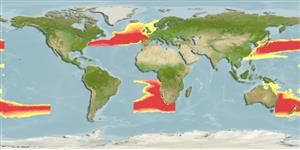>
Ophidiiformes (Cusk eels) >
Bythitidae (Livebearing brotulas)
Etymology: Parabrotula: Greek, para = the side of + Latin, brotula, -ae = little, bud, shoot (Ref. 45335).
Environment: milieu / climate zone / depth range / distribution range
Ecología
marino batipelágico; rango de profundidad 0 - 3000 m (Ref. 35509). Deep-water
Northeast Atlantic: most of the known specimens from the area (Ref. 36126). Eastern Atlantic: Gulf of Guinea, one specimen 0°42'S, 7°E (Ref. 10800). Southeast Atlantic: off East London, South Africa. Western Pacific: Japan and Australia (Ref. 11228).
Tamaño / Peso / Age
Maturity: Lm ? range ? - ? cm
Max length : 5.4 cm SL macho / no sexado; (Ref. 35509)
Short description
Claves de identificación | Morfología | Morfometría
Espinas dorsales (total) : 0; Radios blandos dorsales (total) : 37 - 41; Espinas anales: 0; Radios blandos anales: 34 - 38. Body long, naked and compressed. Skin loose, thin but not gelatinous. Snout pointed. Gill opening large. Head and body uniformly dark brown in alcohol (Ref. 35852).
Found on the continental slope (Ref. 75154). Viviparous (Ref. 10800). Minimum depth from Ref. 58018.
Life cycle and mating behavior
Madurez | Reproducción | Puesta | Huevos | Fecundidad | Larva
Anderson, M.E., 1986. Parabrotulidae. p. 343. In M.M. Smith and P.C. Heemstra (eds.) Smiths' sea fishes. Springer-Verlag, Berlin. (Ref. 6608)
IUCN Red List Status (Ref. 130435: Version 2024-2)
Threat to humans
Harmless
Human uses
Pesquerías:
Herramientas
Special reports
Download XML
Fuentes de Internet
Estimates based on models
Preferred temperature (Ref.
123201): 3.7 - 10.6, mean 6 °C (based on 497 cells).
Phylogenetic diversity index (Ref.
82804): PD
50 = 0.8750 [Uniqueness, from 0.5 = low to 2.0 = high].
Bayesian length-weight: a=0.00102 (0.00046 - 0.00225), b=3.06 (2.88 - 3.24), in cm total length, based on all LWR estimates for this body shape (Ref.
93245).
Nivel trófico (Ref.
69278): 3.2 ±0.5 se; based on size and trophs of closest relatives
Resiliencia (Ref.
120179): Bajo, población duplicada en un tiempo mínimo de 4.5-14 años (Assuming Fec<100).
Fishing Vulnerability (Ref.
59153): Low vulnerability (10 of 100).
